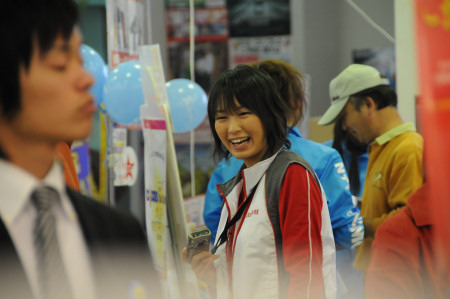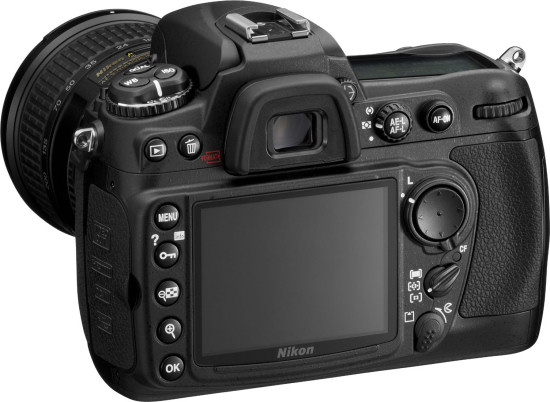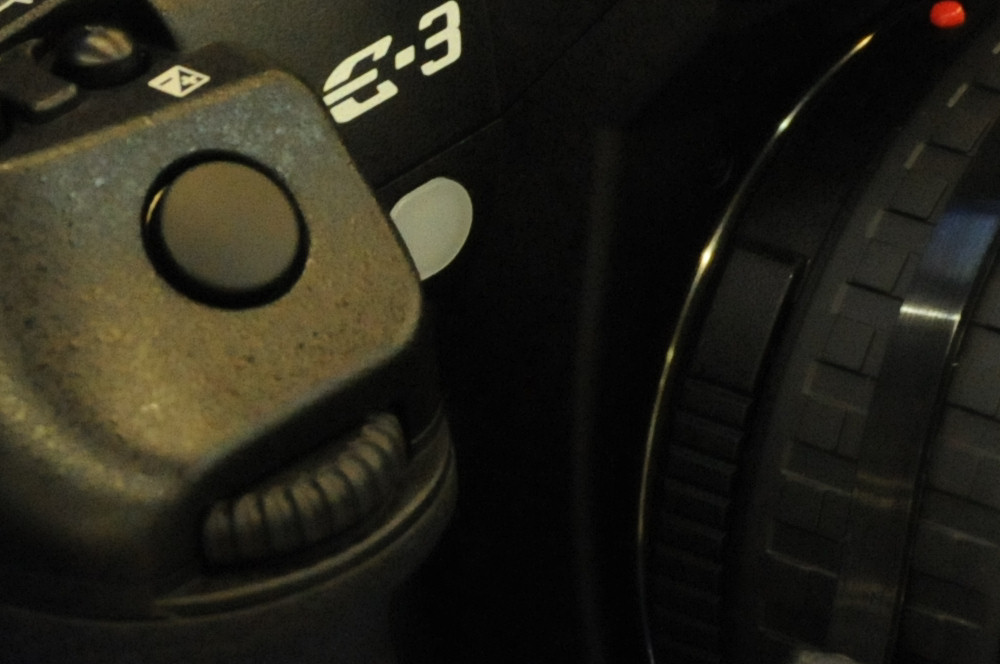Visits: 416
I went to a local electronic shop in Japan today – DeoDeo. Main purpose is to try out the Nikon D300 system but I have found another surprised of Olympus E-3 professional DSLR. 🙂
Thanks to my wife, she helped me to take care of Megumi for nearly an hour, so I have the time to try out the D300 and pull out my D200 and insert my memory card into the D300 to test and get the photos I want.
(I find the photo below kinda cool…D300 is considered as a little brother to Nikon D3, sharing many similarities.)
Before I go to the ISO comparison shots, let’s share a bit of how I feel about the D300.
For the first time I viewed through the D300 viewfinder, I felt that the screen is extremely bright and clean! Yes, clean. Unlike Nikon previous DSLR, you don’t see all the AF point in the viewfinder. Instead, only the focus point that is currently being used is shown. On Nikon D200, you can see 11 focus points in the viewfinder, but on the D300 – which has 51 focus points, you only see the one that is in focus.

(image from http://www.digitalreview.ca/content/Nikon-D300-Digital-SLR-Camera-Pg2.shtml)
The AF tracking and locking in Nikon D300 is really interesting (not sure if it is accurate or not, as there are user reports of faulty AF system in D300)! Once you lock focus on a subject, move your DSLR around with the subject changing position in your frame, D300 will smartly continue to lock focus on the subject by changing the focus point. Yes, you can actually see the focus point moving while you move the camera around. This is a great improvement over current AF system in my opinion, as new way of tracking focus and making sure that your subject is always keep in focus. Another innovative technology and design from Nikon, definitely surprising me. 🙂
Another great improvement on the D300 is what I have always dislike about Nikon DSLR, the buttons at the back of the DSLR. It is really a stupid and un-user-friendly design in Nikon D200 when you want to view a photo and zoom in and out. On Nikon D200, you have to press Enter button once to go to zoom mode (zoomed in slightly), then use the thumbnail button + scroll wheel to zoom in and out. This design is really pain to use. Now Nikon has finally realized that and in cooperate zoom in and zoom out buttons directly on the D300. Yeah, much easier to use and no need to go fancy with the wheel scroll and give us just the two zoom buttons!
D300 – Back
D200 – Back
People have been praising and huh-hahing a lot about how good the D300 LCD is. Now my huh-hah…yes, it is indeed a GREAT LCD! It is bright and crisper sharp in details! Not only that, I found zooming and shifting/viewing pictures on the LCD to be very responsive and fast. This could be due to the new EXPEED processor used in the D300. I am sure Nikon has been using great and fast processor in their previous DSLR, but they do not market it well like the Canon (DIGIC I, II and now III), which has become a symbol of high speed image processing and great image quality! So, Nikon has now branded their processor as EXPEED, though late but definitely not too late. However, it takes time for people to remember the processor name and Nikon still have a long way to brand the processor. They should also consider putting the EXPEED processor in their consumer P&S, just like what Canon did. 🙂
Ok, enough talking of the D300 above…here’s the comparison shots of Nikon D300 and D200 in different ISO setting:
Notes:
- Nikon D300 + AFS 18-200VR with VR OFF
- Nikon D200 + Tamron SP 17-50mm F2.8
- Both cameras use Manual exposure with same settings. Exif are intact in the photos.
Here’s the full view of the test shot (I use Olympus E-3 as my test subject, as it is black and dark, which is perfect in showing noise):
All the shots below are 100% crop from the similar angle of view like the above. No processing or editing of image other than just cropping (1000 x 664 px)
D200 @ ISO800
D300 @ ISO800
D200 @ ISO1600
D300 @ ISO1600
D200 @ ISO3200
D300 @ ISO3200
Finally, before I end this small / short article, here’s some photos taken by the D300 at high ISO. Click the name above the photo to view FULL RES PHOTO (Warning, big file!):
That’s all for now. Hope you enjoy my writing above. Do feel free to leave comment or feedback, this encourage me to write more in future. 🙂























Hi KK, great article. I mostly concur with your findings on the D300. However, just out of curiousity, why are there a major difference in the colours rendered from the D200 and D300? Are both on AWB?
Anyway, I’m very impressed with the D300. For the price it does offer good value, and definitely an improvement over the D200.
Hi Wesley,
Both are set to AutoWB. I think the D300 AutoWB is better than the D200. The D300 colour is more accurate to real life situation.
KhoKing
The colour seems warmer on the D300, and did you try the MB-D10? Wanna know if the grip is solidly attached to the body as lack of battery insert arm. The DSC_0032 a tad out of focus, was it due to fact that the D300 miss-focused? Is the handling (when shutter clicks) quieter and less vibration induced than D200?
hi Hun,
No, I have not tried the MB-D10. Not available in the store that I visited.
My main purpose of testing out the D300 is high ISO quality, so I did not really notice or check the shutter sound difference, but if my memory serves me well, both D200 and D300 have very similar shutter sound and D300 being a bit quieter.
Vibration wise, hard to notice any difference. Vibration test need to be tested on tripod with both camera set at same shutter speed and condition, then compare the two photos side by side. I don’t have the chance to do that kind of comparison. If someone could loan me a D300 for a week, then I can do more extensive review and comparison. 😀
Hi KK
I am a proud new owner of a D300 , havent used it yet , its on way froim US. The difference between D3 and D300 are significant due to the high ISO and full frame CMOS image conversion but the price difference is too high , what do you think
Hi Suvy,
Personally I think D300 is a very successful camera, just like D200. Nikon has created a great value DSLR that many will want to buy. D300 high ISO has been a great improvement as compared to D200.
For owner of D200, it is not a very significant upgrade. However, for new comer or those owning D80 or below range DSLR, D300 will be a great upgrade to them. I was upgrading from D70 to D200 few years ago, the difference is huge. Similar case to D300 now.
As for D3…it is a great DSLR! People have been wanting a full frame Nikon DSLR for a long time, and Nikon answers us with a great D3! Demand for D3 is so high now and most places are on order/queue…unlike D300 which is easily available now.